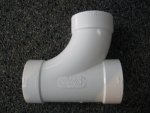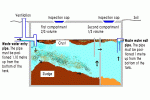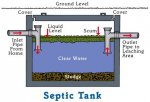What's the least complicated way to set up a "settling tank" (or other way to catch the bigger pieces of debris) before that water gets to the bio media? Physical space and a limited brain are issues

M,
I know that I have posted this here somewhere on the forum, but I don't recall where or to whom I was responding.
Anyway, the most effective, efficient and maintenance friendly system for removing solid wastes and debris from the water as a "prefilter" or "settling filter" is through the adoption of the same principle that is utilized in septic tanks for homes.
It is a very simple design and very easy to build and to maintain.
The discharge water from the pond is let into a (let's say a barrel or drum for simple discussion) via a 2" PVC pipe. This pipe enters the drum up high - maybe 3/4 the height of the drum. The outlet of effluent water exits the opposite side of the drum just an inch or two below the level of the inlet pipe.
Inside the drum, on the inlet side, the incoming PVC pipe is connected to a "sweep tee" fitting. You know what a "Tee" pipe fitting looks like, that is easy to envision, just think of the letter T. A sweep tee simply puts a "curve" in the center port of the tee that faces or directs water flow to one side of the top of the T. That curved portion is directed downwards into the drum and a length of PVC pipe is connected below the T to force the water and sediments towards the bottom of the drum. The other side or the top of this T is left open to the air space at the top of the drum. Maybe a short piece of PVC pipe is attached (just a few inches) to prevent the water and sediments from overflowing here, it is meant to be just a vent to prevent a vacuum area here.
On the outlet side, the identical connections are made with another sweep tee.
The difference between the inlet and the outlet sides are that the outlet pipe is one or two inches lower than the inlet pipe AND, the pipe that drops down towards the bottom of the drum is shorter on the outlet side. Hence vertical PVC pipe on the inlet side may stop two to four inches above the bottom of the drum, but the vertical PVC pipe on the outlet side stops six to eight inches above the bottom of the drum.
Try to draw what I am stating out on a piece of paper and it may click in your mind what is going to happen with solids and sediments here. The solids that are heavier than water will sink to the bottom of the drum and cannot find the outlet or exit pipe. Those that are lighter, will float to the surface, but cannot find the exit pipe, either. Hence they are trapped! Natural bacteria will develop in this tank and break down the waste products into a safe sludge.
In a septic tank system, it is intended that the top of the drum be opened and the sludge "sucked" out with a pumper truck. For a system like this being used for a pond, you can fit a drain line at the bottom of the drum and just open a valve and purge it out, water and sludge and all, into your garden area and use it for good fertilizer.
This sediment or solids filter is so very simple to construct and there are no pumps or mechanical devices to contend with, except the valve to open and close the drain line.
You can make this more elaborate by adding baffles in the space between the bottom of the inlet pipe and the botom of the outlet pipe if you wish. Baffles will break the flow of the water so that the lighter solids and sediments will drop out at the bottom of the drum more easily. A few layers of the ceiling lighting grates stacked so that the holes are at different angles should be enough to slow the water flow so that more of the finer, but heavier than water debris, settles to the bottom more readily.
It's a similar principle to a snow fence. If you put up one snow fence, it cuts the speed of the wind and the slower the wind is, the less snow it can carry with it, so the snow drops out of the air in front of the fence. Put up another snow fence downwind from the first, and you drop out even more snow. Put up several snow fences in parallel lines (perpendicular to the main wind direction) and all the snow drops out of the air before it drops out over your road or driveway. Hey! No need for a snowblower!
It is all mechanical physics. But, don't let the principles of physics scare you. They are simple laws of nature that you witness everyday, just put them to use for your own benefit. Let NATURE work for you! It is so simple in theory and so simple in design and construction.
You do not require a huge amount of space and you don't have to be a great wizard to accomplish this. Just a little time and effort and some cheap PVC pipe and some water holding vessel. Could be a drum or a rubbermaid box container or an old water heater tank, etc. Whatever you can get your hands on. The taller the better, but I wouldn't go taller than 3-4 feet or shorter than 24 inches. Depends on how much water you are servicing and how fast.
Does my idea register well with you? Or did I lose you along the way? I can clarify anything if you like, just holler at me or research septic tank designs.
Gordy







